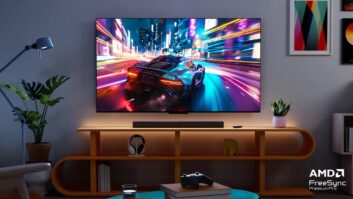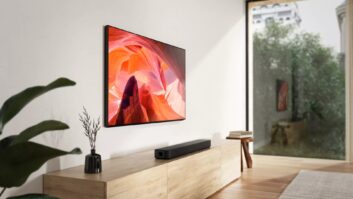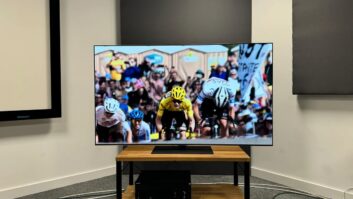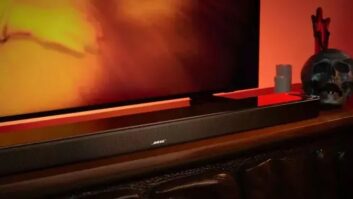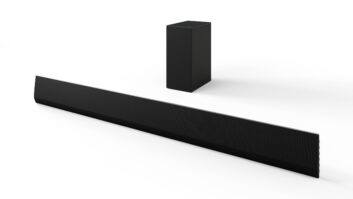Kudos: Clear, articulate dialog; solid bass performance; impressive vertical soundstage; incredibly easy to setup and great built-in demo
Concerns: Randomly dropped wireless speakers; limited overhead “height” effect
Speaker manufacturers now realize there is a market for upscale, high-performance soundbars, with customers willing to pay for advanced features such as streaming audio and Dolby Atmos. Still, the vast majority of bars offering Atmos capability rely on Dolby’s upfiring speaker technology, which delivers performance that is highly room dependent and can be difficult to create a truly encompassing effect. However, Sony really impressed me with its HT-ST5000 (read that review here), a bar that repeatedly delivered those “I can’t believe there aren’t any speakers in the celling!” moments. But the ST5000 had two major limitations: it was pricey and couldn’t support true surround speakers.
At this past CES, Sony rolled out its next-generation Atmos soundbar, the HT-Z9F. Not only does this bar cost significantly less than the ST5000, it supports DTS:X and optional wireless surround speakers for a more immersive, surround effect. However, unlike the ST5000, the Z9F is only a 3.1-channel bar, with no actual upfiring “height” speakers. Rather, Sony uses some audio DSP secret sauce it calls “Vertical Surround Engine” or “Vertical S.” for short. Sony claims the bar is not ceiling dependent, as it doesn’t “bounce” sound off the ceiling like upfiring speakers do, and that ceiling height, design, or construction doesn’t affect performance.
We’ll see.
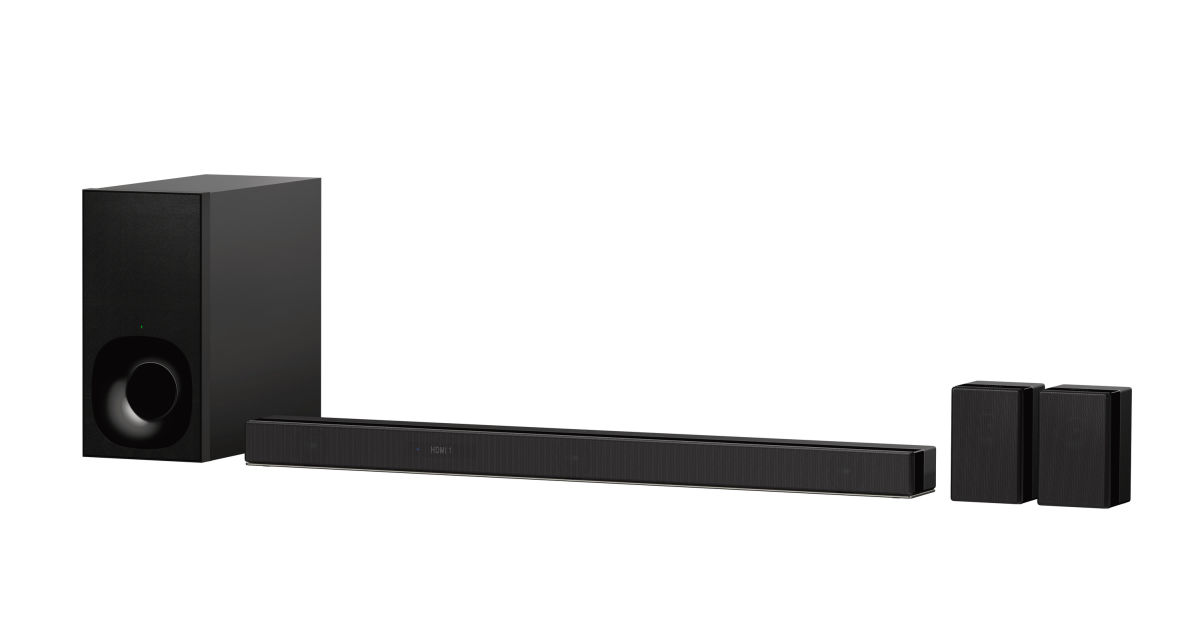
The bar offers enough connections for a basic system, including two HDMI 2.0a/HDCP 2.2 inputs, as well as an output that supports ARC. These are 18 Gbps inputs supporting 4K HDR, including Dolby Vision and HLG (Hybrid Log Gamma). There is also a Toslink digital input, mini-jack analog audio input, and a USB connection. I appreciated that all connections are positioned where they can be accessed even with the bar wall-mounted. The Z9F can access the network either via wired RJ45 LAN connection or 2.4/5 GHz dual-band WiFi. I didn’t love the wall mount solution, which is basically two small hangers the bar secures into, but which hold the speaker off the wall roughly ½-inch. (I was told this was due to thermal concerns.)
Setup is fast and straightforward via an attractive onscreen GUI. A tad disappointing is that, unlike the HT-ST5000, the Z9F doesn’t offer any Control4 integration (short of infrared). [UPDATE: According to Sony, the HT-Z9F is now certified by Control4 for IP control and will Control4’s library shortly. The firmware update will be released in the next month or so.]
Also reviewed by John Sciacca: Sony HT-ST5000 7.1.2 Dolby Atmos Soundbar
While the included remote is serviceable — with direct access to all inputs and sound modes — it continues Sony’s maddening trend of omitting any backlighting. Also surprising/disappointing is the bar’s lack of ability to learn third-party IR signals, say the volume commands from the TV or cable remote. (An IR repeater mode can pass commands through the bar when sitting in front of a TV.) There are some controls on the top of the bar, but these are kind of difficult to see and use.
Once powered on, the bar automatically found and connected to the wireless subwoofer and it was ready to go. For rears, Sony offers the SA-Z9R, a pair of dedicated wireless rear speakers for the Z9F. Again, these are totally plug-and-play, with the bar automatically finding and adding them once they were powered on. #ProTip: Pay attention to the “REAR R” and “REAR L” label on the back of each speaker to know which is which.
During my months with the Z9F, I experienced several occasions where the bar randomly lost connection with either the sub or rear speakers, or both. While simply unplugging the bar from power and reconnecting it generally re-established connection, this was irritating and happened enough that it was worthy of note.
The bar offers no calibration or microphone setup, but does let you adjust distance and levels for front, sub, and surround (left and right independently) channels. There is no ability to adjust the Vertical S. level or effect short of turning it on or off.
Beyond just providing audio for your video, the Z9F offers several music streaming options as well. Music can stream across the home’s network, or via an attached USB drive, and the Z9F supports a huge variety of file formats, including MP3, AAC, WAV, DSD, AIFF, ALAC, and FLAC, handling Hi-Resolution Audio up to 192kHz/24-bit resolution. It also supports Spotify Connect and Google’s Chromecast, meaning you should be able to enjoy your favorite streaming station and it can be part of a house-wide music system. Also cool is it offers voice control via both Alexa and Google. For example, say, “Alexa, play Jazz on the soundbar” and music will begin. You can also have Alexa stop the music or adjust the volume. The Z9F can both receive and transmit Bluetooth signals, meaning you can beam audio to it from a smartphone or have the bar send audio to Bluetooth headphones; a fantastic solution for clients that are hard of hearing. (Unfortunately, audio from the Z9F itself is muted when transmitting.)
I’ve found when customers are purchasing something based on a specific feature — in this case playing Dolby Atmos and DTS:X audio — they generally want to see that it is doing this. One of my nits with the HT-ST5000 was its lack of any kind of Dolby Atmos indicator. The Z9F addresses this with a Display button that that clearly shows Dolby Atmos or DTS:X loud-and-proud up onscreen when the appropriate format is being received.
I lived with the Z9F in my bedroom for several months, during which time we watched a ton of TV, sports, Netflix, and Blu-ray movies, and the Z9F rarely disappointed. When watching sporting events such as the World Series or college football (Roll Tide!), the bar kept the announcer’s voices clear and intelligible up front while the Z9R rears surround me with crowd roars. While I’m generally loathe of DSP sound modes, the Z9F features a “News” mode that does a good job of knocking down ambient sounds to make dialog more intelligible, which might be useful for some viewers.
The bar really shines when it comes to playing back content that is actually Atmos or DTS:X encoded. For example, watching Dwayne “The Rock” Johnson’s latest opus, Skyscraper, in Atmos featured a wide and encompassing presentation. In one fight scene, a bullet shell casing hits and skitters across a hardwood floor, and you can hear it bounce and travel far left of the bar. In another scene where Johnson’s character, Will Sawyer, is trying to break into The Pearl, the sounds of machinery, cabling, destruction, and a hovering helicopter fill the room, with audio extending well above the screen to the front ceiling, with terrific front-to-back integration with the surrounds.
Jurassic World: Fallen Kingdom in DTS:X was another sonic smorgasbord on the Z9F, with virtually every scene offering some surround workout. The opening of the film features an employee attempting escape from a T-Rex, with a helicopter flying overhead, a pouring rainstorm, and weighty foot stomps and roars from the giant dino. The bar produces a massively wide and tall soundstage that feels like a far larger system. This is especially true when you add in the surround speakers, creating a true sonic bubble.
The bar includes an incredibly handy and effective built-in Demo mode that I found great for giving short demos to family and guests. Press and hold a button on the top of the bar and it goes into a short demo that features traffic sound, a helicopter, fireworks, a rain storm, and other sounds that do a fantastic job of quickly demonstrating the immersive audio the bar is capable of producing. This is a great feature for quick showroom demos.
There’s no question that Sony’s Vertical S. works, as toggling it on produces a noticeably larger presentation, while the soundfield collapses significantly when off. More importantly, it seems to do this with very little negative effect to the sound, and I preferred to leave it on all the time. (Interestingly, when listening to music, turning Vertical S. on also activates DTS: Neural, sending audio to the rear speakers. Turning Vertical S. off, turns the rear speakers off as well.) While audio is definitely well above the bar, and frequently sounded like it extended up to the front ceiling location from my typical viewing distance — about 12 feet from the bar — I didn’t feel it offered the same “audio directly overhead” immersion as the ST5000. The height effect greatly improves as you get closer to the bar — say around 5-6 feet away. At this location, the height effect improves dramatically, so I would say the Vertical S. virtual height info tends to perform better in smaller rooms with a closer seating distance.
The HT-Z9F does a ton right, tremendously improving the TV and movie watching experience in rooms where a traditional surround system isn’t practical or possible. It sounds especially impressive when paired with the SA-Z9R surrounds, which I would consider a pre-requisite for use. Factor in its music streaming capabilities and competitive price, and you’ve got a winning package.
Product Specs
• 3.1.-channel surround bar, with three 1.75-inch full range speakers powered by 300-watt amplification (100-watts per speaker); wireless subwoofer features 6 3/8-inch active driver powered by 100-watt amplifier
• Decodes Dolby Atmos (True HD) and DTS:X
• Supports large array of audio file formats including AIFF, ALAC, DSD, FLAC, .WAV, MP3, WMA up to 192/24 resolution
• Bluetooth A2DP, AAC, LDAC; Spotify Connect, GoogleCast
• WiFi 2.4GHz/5 GHz 801.11 a/b/g/n
• Inputs: 2 HDMI 2.0a/HDCP 2.2, 3.5mm analog audio, Toslink digital, Gigabit Ethernet RJ45, USB Type-A; Outputs: HDMI 2.0a/HDCP2.2 with ARC
• Optional SA-Z9R Wireless Rear Speakers feature a 2-inch full range driver powered by 50-watt internal amplifier
• Dimensions:
- Bar: 39 3/8 x 2 5/8 x 4-inches (W x H x D), 6 pounds 13 ounces
- Sub: 7 1/2 x 15 1/8 x 15 1/4-inches (W x H x D), 17 pounds 14 ounces
- SA-Z9R Rears: 4 x 6 1/8 x 4 (W x H x D), 2 pounds 3 ounces






